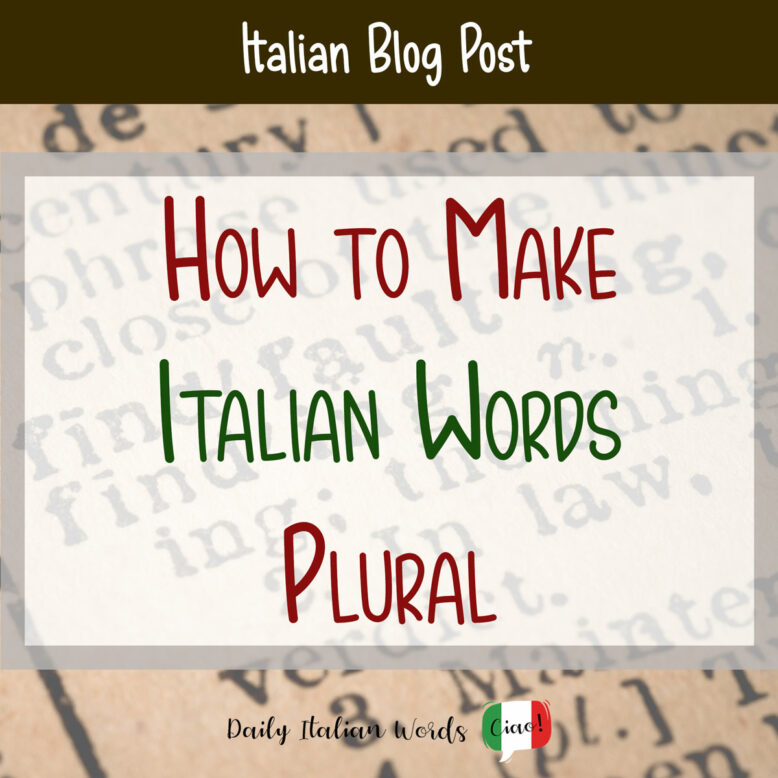Italian is a language of fascinating nuances, one of which is the way it pluralises words. While it may seem like simply changing the final vowel is all there is to it, there is so much more to discover.
In this blog post, we’ll take a closer look at the different ways to make Italian words plural, including regular and irregular forms. No matter how far you are in your Italian learning process, this guide, complete with examples, will help you sound like a native speaker in no time!

General rule to make Italian words plural
Let’s start with the basics. The plural form of an Italian word is usually determined by its gender and ending vowel. In Italian, masculine nouns mostly end in -o (like libro), while feminine nouns generally end in -a (like casa).
Once you identify the gender of a noun, the most basic way to make Italian words plural is by changing the ending from one vowel to another: -o becomes -i (libri), and -a becomes -e (case).
Of course, you’ll also have to change the definite article: il, l’ and lo (the definite articles for masculine singular nouns) become i or gli, while la and l’ (the definite article for feminine singular nouns) become le.
So, to summarize:
Feminine words ending in -a
The plural is made by replacing the final vowel -a with -e, while the article changes from la or l’ to le.
Examples:
la mela (the apple) > le mele (the apples)
l’anatra (the duck) > le anatre (the ducks)
Take note:
- in feminine nouns ending in -ca, the plural is -che: la zucca (the pumpkin) > le zucche (the pumpkins)
- the same goes for feminine nouns ending in -ga, whose plural is -ghe: la spiga (the spike) > le spighe (the spikes)
Masculine words ending in -o
The plural is made by replacing the final vowel -o with -i, while the article changes from il to i, or lo to gli, or l’ to gli.
Examples:
il vino (the wine) > i vini (the wines)
lo sconto (the discount) > gli sconti (the discounts)
l’allenamento (the training) > gli allenamenti (the trainings)
Take note:
- in masculine nouns ending in -co, the plural is -chi: il fuoco (the fire) > i fuochi (the fires)
- the same goes for masculine nouns ending in -go, whose plural is -ghi: il mago (the wizard) > i maghi (the wizards)
Feminine / masculine words ending in -e
Italian also has a lot of feminine and masculine words ending in -e and they are pluralised with -i.
Examples:
il ristorante (the restaurant) > i ristoranti (the restaurants)
la canzone (the song) > le canzoni (the songs)
il fiore (the flower) > i fiori (the flowers)
That’s pretty straightforward, isn’t it? However, there are a few interesting exceptions when it comes to making Italian words plural. So, now for the fun part!
Making unchangeable nouns plural in Italian
Some Italian words remain unchanged in their plural form, making it easy for you to simply use the plural article. Here are some of the most common ones.
Words ending with a stressed vowel
Stressed vowels stay the same in the plural; only the article changes.
Examples:
la città (the city) > le città (the cities)
il caffè (the coffee) > i caffè (the coffees)
la gioventù (the youth) > le gioventù (the youths)
Nouns ending in -si
There’s no plural form for singular nouns ending in -si.
Examples:
la crisi (the crises) > le crisi (the crises)
il brindisi (the toast) > i brindisi (the toasts)
l’analisi (the analysis) > le analisi (the analyses)
Feminine nouns ending in -ie
Some feminine words ending in -ie don’t have a plural form either.
Examples:
la serie (the sequence) > le serie (the sequences)
la specie (the species) > le specie (the species)
la carie (the cavity) > le carie (the cavities)
Masculine nouns ending in -a
There are some masculine words ending in -a (often referring to exotic animals) that stay the same in plural form.
Examples:
il gorilla (the gorilla) > i gorilla (the gorilla)
il lama (the llama) > i lama (the llamas)
il cobra (the cobra) > i cobra (the cobras)
Words ending with a consonant
These are often words of foreign origin and don’t change when you make them plural.
Examples:
il bar (the cafe) > i bar (the cafes)
il film (the film) > i film (the films)
il computer (the computer) > i computer (the computers)
Abbreviated nouns
Abbreviations make words easier to write and say, like metro, which is short for metropolitana. In plural forms, these nouns keep the same ending.
Examples:
l’auto (the car) > le auto (the cars)
la foto (the photo) > le foto (the photos)
la moto (the motorcycle) > le moto (the motorcycles)
Monosyllabic words
When a word has only one syllable, it stays the same in the plural.
Examples:
il re (the king) > i re (the kings)
la gru (the crane) > le gru (the cranes)
lo sci (the ski) > gli sci (the skis)
Italian nouns with irregular plurals
Adding a touch of intrigue to the way we make Italian words plural, there are certain nouns that deviate from the standard rules.
Masculine nouns ending in -a
Some masculine words end in -a (yep, like most feminine words) and are pluralised by changing the final vowel to -i.
Examples:
il turista (the tourist) > i turisti (the tourists)
il problema (the problem) > i problemi (the problems)
il poeta (the poet) > i poeti (the poets)
Feminine nouns ending in -o
Similarly, some feminine nouns end in -o (like most masculine words), so they’re pluralised with -i. Fortunately, there aren’t many of them.
The most common word in this category is la mano (the hand) > le mani (the hands)
Words ending in -cia or -gia
When we speak, mistakes can often slip by unnoticed, as with this group of words. But when it comes to written texts, those errors stand out starkly. So, here’s the general rule:
– If a vowel precedes the syllable -cia or -gia, the word keeps the vowel in the plural.
For example:
la farmacia (the pharmacy) > le farmacie (the pharmacies)
la ciliegia (the cherry) > le ciliegie (the cherries)
– Alternatively, if a consonant precedes the syllable, the word loses the vowel in the plural.
For example:
la mancia (the tip) > le mance (the tips)
la spiaggia (the beach) > le spiagge (the beaches)
Pluralising compound words in Italian
Some compound words in Italian can be really tricky to pluralise. However, don’t fret! Here are some general rules to help you:
In cases where the two words are the same gender, the plural can be formed by changing just the ending of the second word.
Examples:
franco (masculine) and bollo (masculine)
il francobollo (the stamp) > i francobolli (the stamps)
arco (masculine) and baleno (masculine)
l’arcobaleno (the rainbow) > gli arcobaleni (the rainbows)
When two words have different genders, only the first changes the ending.
Examples:
capo (masculine) and stazione (feminine)
il capostazione (the station master) > i capistazione (the station masters)
pesce (masculine) and spada (feminine)
il pescespada (the swordfish) > i pescispada (the swordfish)
When a compound name is made up of a noun and an adjective, it changes the ending of both words in the plural form.
Examples:
la cassaforte (the safe) > le casseforti (the safes)
il camposanto (the cemetery) > i campisanti (the cemeteries)
There are additional rules for making Italian compound words plural, but I’d limit them to the most common ones for now.
Other exceptions in Italian plural
As if the rules and exceptions listed above weren’t enough, there are some really rebellious Italian nouns that have their own weird rules when it comes to plurals.
Some words like to change their root, in addition to the ending, in the plural form.
Examples:
l’uomo (the man) > gli uomini (the men)
il tempio (the temple) > i templi (the temples)
il dio (the god) > gli dei (the gods)
In some cases, pluralising words changes the gender.
Examples:
l’orecchio (the ear – masculine) > le orecchie (the ears – feminine)
il lenzuolo (the bed sheet – masculine) > le lenzuola (the bed sheet – feminine)
il dito (the finger – masculine) > le dita (the fingers – feminine)
Lastly, it’s worth noting that some nouns have multiple forms for the plural – each with its own unique meaning.
For example:
il braccio > i bracci (the mechanical arms) OR le braccia (the arms)
il muro (the wall) > i muri (the walls) OR le mura (the city walls)
In summary, making Italian words plural may seem easy at first glance, but there are quite a few irregular forms that require some memorisation. The good news is, once you grasp the basics of Italian pluralisation, you’ll be well on your way to fluently forming both singular and plural nouns. And with enough practice, listening and repetition, those tricky exceptions will become second nature.
Valentina is a travel writer in love with her country. Having travelled widely around the globe, she realised there was more to explore closer to home and decided to put the passport aside for a while. You can follow her adventures around Italy on her blog myitaliandiaries.com.

Valentina Nicastro is a travel writer in love with her home country, Italy. Having travelled widely around the globe, she realised there was more to explore closer to home and decided to put the passport aside for a while. When she is not immersed in documenting Italy, you’ll find her donning her communication consultant hat, weaving words as a content writer and bridging linguistic divides as a translator.


